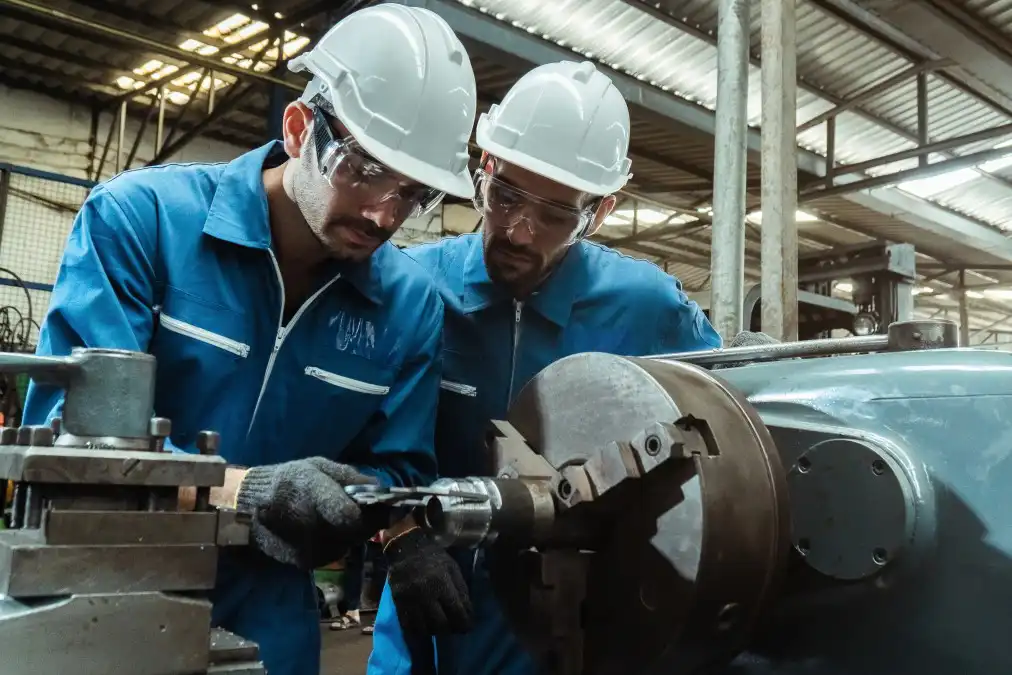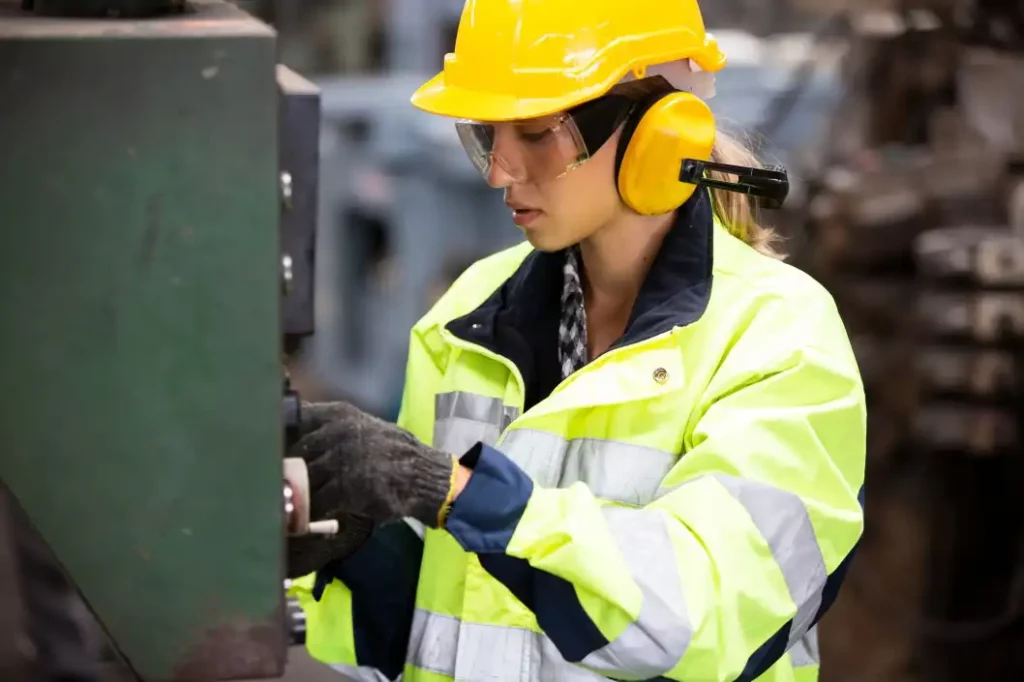If you are working or using a lathe, whether in a workshop or on a job site, you need to be fully aware of any safety concerns. Here are some important safety guidelines to ensure your safety on a lathe.
Lathe safety guidelines before using
- Before each job, inspect and adjust all safety devices.
- Before you begin, double-check that the guards are in place and good functioning order.
- Ascertain that any stationary equipment is securely fastened to the floor.
- Ensure that all machines have a start/stop button that is easily accessible to the operator.
- Ensure that all machines have an emergency stop button (e-stop).
- At any one time, each machine should only have one operator. Everyone should know how to shut down the system in an emergency.
- Before turning on the power, make sure all keys and adjusting wrenches are absent from the machine. Make a tool rack for easy access.
- Make sure all blades and cutting instruments are clean and sharp. They should be able to cut without restriction.
- Before measuring, cleaning, or making any modifications, turn off the equipment.
- Before beginning maintenance or repairs, take the necessary lockout precautions.
- Remove clippings with a vacuum, brush, or rake. Cuttings should not be handled by hand because they are incredibly sharp.
- Keep your hands clear of the cutting head and any other moving parts.
- Avoid awkward hand positions and operations. The hand may slide into the cutting instrument or blade due to a rapid slip.
- After each use, return all portable tooling to its proper storage location.
- After each use, clean all tools.
- Maintain a clean, well-swept, and well-lit work environment. Level floors with a non-slip surface are ideal.
- Ensure there is enough space around the machine to do the task securely.
- It would help to treat all injuries right away.
- Understand that the health and fire risks differ from one substance to the next. Practice all necessary safeguards.
- Suppose there is a risk of a combustible dust situation; clean machines, ducts, hoods, and other areas. Some metal dust has the potential to explode.

Safe guidelines when using a lathe
- Wear safety glasses that are CSA-certified. Others in the area may need to wear safety glasses, as things may fly off the job.
- Ensure no entanglement hazards (e.g., loose clothing, jewelry, etc.). Please tie your long hair back and contain it.
- Remove any obstacles or slip risks from the floor.
- Ensure that the lathe has a start/stop button that is easily accessible to the operator.
- Check for an emergency stop button on the lathe (e-stop).
- Follow the task criteria for speed, feed, and cut depth for turning materials. Ascertain that all work is accurate and centered.
- Drill a hole in the center of the work to stabilize the item while it spins.
- Secure and clamp the piece you’re working on.
- Adjust the tool and tool rest to be slightly higher than the work’s center.
- To handle hefty chucks or work, use a lifting device. For more information, go to Materials Handling.
- Examine the chucks for signs of wear or damage. Flying parts are pretty hazardous.
- After adjusting the chuck, remove the chuck wrench immediately.
- Use a barrier guard when using the lathe in semi-automatic or automatic mode.
- Protect all power transmission components.
- Before operating the machine, remove all tools, measuring instruments, and other things from the saddle or lathe bed.
- Maintain the sharpness of all lathe cutting instruments.
- Before mounting or removing accessories, turn off the motor’s power supply.
- Stop the lathe before collecting any measurements.
- Remove cuttings using a vacuum, brush, or rake only after the lathe has stopped moving.
- Ensure that the work surface is free of scraps, tools, and materials.
- Keep the area around the lathe clean and grease-free.
Safely guidelines after using a lathe
- When the job ends, turn off the machine.
- Ensure that all guards are fully closed.
- Avoid allowing swarf to accumulate on the tool or work. Stop the machine and take it apart.
- Leave the machine in a secure, clean, and orderly condition.
- After each use, remove the chuck key from the chuck.
- Before turning on the power, turn the chuck or faceplate through by hand to ensure there are no binding or clearance issues.
- Before taking measurements, turn off the machine.
- Remove all tools from the tool post and tailstock before cleaning the lathe.

Lathe Machine hazards and controls
Hazards
Hazards are as follows:
- Excessive lifting
- Entanglement or contact with moving elements or loose objects
- Metal chips or swarf contact
- Liquid coolant contact
- Leaking hydraulic hoses
- Use of ineffective tooling and polishing procedures
- Noise
- Falls, trips, and slips
- Unexpected movement causes contact, collision, or entanglement (during maintenance, cleaning & repairs)
Controls
- If necessary, use a mechanical lifting device.
- During loading and unloading, do not use the lathe.
Metal lathe safety checklist
- Locate and familiarise yourself with all machine controls and functions.
- Ensure that all guards are properly installed, secure, and working. If the guards are missing or broken, do not operate.
- Check workspaces and pathways for any potential slip/trip risks.
- Make sure that the job is secured in the chuck.
- Remove all tools from the machine’s bed and slides.
- Ascertain that the correct machining speed is selected.
- Before starting the lathe, remove the chuck key.
Lathe Machine safety guard
The following are the basic principles for manual lathe guards:
- Interlocked chuck guard
- Feed and lead screw safety
- Feed and lead screw safety
- Fixed rear guard
- Safety levers and emergency stop
- Cover for the gear drive (fixed or interlocked)
- Turn off and bring the machine to a complete stop before making modifications or measurements.
- Disconnect the chuck key from the chuck at all times.
Lathe Hazards list
- Flying things, such as the chuck key accidentally left in the chuck.
- Cleaning, filing, or polishing a cutting instrument can cause harm.
- Hair or garments becoming entangled in moving machine parts.
- Metal shards and swarf
- Eye injury.
Operating safety precautions
It would help place emergency stop buttons in easily accessible positions on the machine. These buttons allow the operator to swiftly stop the device in a failure or an emergency circumstance, e.g., entangled. You can easily find these buttons near the operation controls. For cleaning chips or measuring the workpiece, never approach a revolving workpiece. Stop the machine and wait for it to completely stop if you need to measure or clean the workpiece. If you’re working on a big or awkward piece, enlist the help of another person or a lifting device to help you lift and secure it.
- Pyrography Techniques for Beginners: Textures and Shading - January 23, 2024
- Troubleshooting Jointer Issues: Why is Your Jointer Not Flattening Wood? - October 11, 2023
- Unlocking the Secrets of Jointing to Increase Width - September 29, 2023
